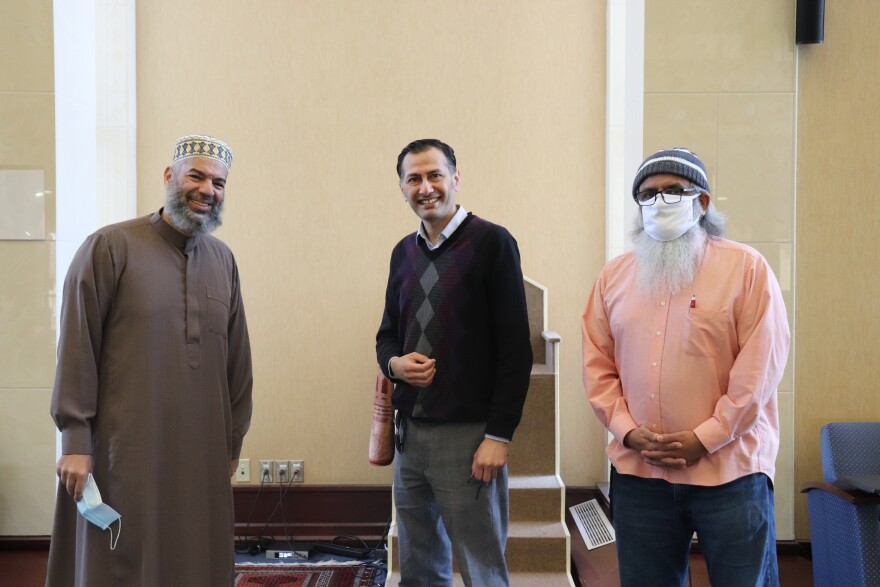Inside Noor Islamic Cultural Center, Imam Abdel Moneim is reciting Dhuhr, one of five daily prayers in Islam that happens around noon. Men are sliding off their shoes, laying down prayer mats, and kneeling with their heads bowed to the ground.
Moneim is glad to be praying with others again after five months of virtual services.
“We couldn’t actually accept anyone in the mosque here,” Moneim says. “But I was praying in the mosque here, and we were trying to put it online so people could follow us.”
Noor Islamic Cultural Center is the largest mosque in Central Ohio. Before the pandemic, up to 800 people would pack themselves in this room, standing shoulder to shoulder. Thousands would come through on the weekends.
But now, neon yellow tape marks six feet of space for people’s prayer stations. It’s a strange sight, says interim director Azhar Masood.
“I think we have 100 or 150 people only with six feet of distance, 150 max,” Masood says.
Spacing everyone out means only about 10% of the usual crowd can pray inside the mosque. Noor is still offers virtual services for the 90% that can’t fit in the building, but mosque leadership hopes with time and vaccinations, that will no longer be necessary.
At the start of the pandemic last March, Ohio ordered a number of industries closed – restaurants, hair salons, gyms. But Gov. Mike DeWine specifically carved out houses of worship, citing the First Amendment.

Even so, many voluntarily converted to online-only services, like St. Catherine’s in Bexley, where Father Daniel Dury is head pastor.
“I have to say that I did cry,” Dury said last year. “I cried because I wasn’t able to offer mass and bring Christ to my people.
Although some religious leaders have returned to in-person worship, or plan to make the shift as Ohio vaccinates more people, others have changed their religious practices for good.
Zoom Just Isn’t the Same
Masood says he hopes that normality is coming soon, because the pandemic is significantly hurting their budget. He notes the difference between pre- and post-pandemic donations at Friday prayers.
“It was anywhere from $10-12,000 a month kind of thing, it went to less than $2,000 or $3,000,” Masood says. “You can see the huge difference we had.”
Since the mosque has decreased operations, that financial hit is O.K. for now. But if it doesn’t turn around as more people come, the mosque might have to shut down some of its programming – things like after-school activities and community meals.
Visitors like Asma Mostafa are relieved for the opportunity to pray in the mosque again.
“Zoom did not replace being here physically in the center during that time,” Mostafa says. “It did help a little bit, but it’s not the same at all. So that was tough to practice your prayers.”
It’s a sentiment that Father Daniel Dury echoes.
“Doing it virtually is good if we don’t feel safe and we’re vulnerable,” Dury says. “But once we get through this pandemic, we really need to come back. It’s not the same thing.”
St. Catherine’s, like Noor, still offers online services. Inside the church, though, every other pew is roped off, reducing capacity.
“Ash Wednesday was our biggest attended mass in about a year, over a year for sure,” Dury says. “I would say it’s over 50% of our parishioners who are now coming back in-person.”
The Catholic Church hasn’t been hit as hard financially by the pandemic. Across the Columbus Diocese, donations across parishes collectively went down 2%, while donations at Dury’s church went down just 1%.

If You Reopen, Will They Come Back?
Still, many worshippers plan to stay away for the near future.
Blake Miller faithfully attends weekly services for Columbus Mennonite Church online, a series called “Worship in Place.”
“I really enjoy the sharing on Sunday mornings of, we have a time of sharing of joys and concerns where you can really, it feels like a way to connect with that community of hearing what struggles people are going through or what good things have been going on,” Miller says.
He’s glad church remains virtual to mitigate the spread of COVID-19, but he looks forward to the day when that's no longer necessary.
“I definitely hope to return to in-person services,” Miller says with a sigh. “Who knows when that will be, if people get vaccinated, you know. I am sure it’ll go back to in-person when the health experts say that it’s O.K.”
It's an open question if religious services across the board will look the same as they did before. Dury isn’t sure.
“As to whether or not some people will never return? It’s a good question," Dury says. "I hope that they do. I hope that they do, because we love them and want them to be a part of our family.
"But I suspect that that’s the case. That perhaps people will say, ‘Well, I don’t know if I need to come back.’”
Dury says only God knows what will happen.
What questions do you have about COVID-19 or Ohio's response? Ask below and WOSU may answer as part of our series A Year Of COVID.
_





